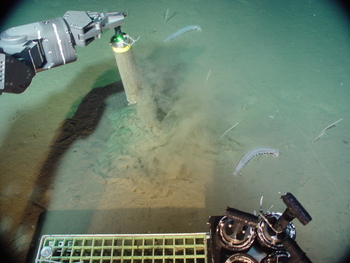Sediment and Gas Hydrate Sampling
Seafloor sediments
The western margin of North America hosts thick sedimentary sequences deposited from 1) rivers during the last glaciation events, and 2) material scraped off the downgoing Juan de Fuca Plate as it is subducted beneath North America. Sampling of these types of sediments during the Enlighten '10 cruise focuses on the following objectives: 1) to understand the composition, "strength," and coarseness (e.g., silt, sand, cobbles) of these sediments to optimally determine the placement of Primary and Secondary cabled infrastructure for the Regional Scale Nodes; 2) to understand the nature of gas hydrate deposits at Southern Hydrate Ridge; and 3) to understand the age of sediments on Axial Seamount.
Sediment sampling will be done in two ways during Enlighten '10. The first method will be to use a gravity core that is allowed to free-fall into the sediment, penetrating 2 to 3 meters into the sediments. The gravity core is brought back up onto the deck of the ship using a cable and the sediments are retrieved from the long, plastic core liner. The second method, which is for more detailed sampling at Hydrate Ridge and Axial Seamount, is a "push core" that uses 2.5- 3-in. diameter plastic tubes that are pushed into the sediments by Jason's robotic arm. A quiver of push cores allows multiple samples to be recovered on a single dive.


